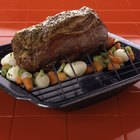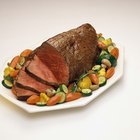
whitetag/iStock/Getty Images
A pork roast is safe and ready to eat once its internal temperature reaches 160 degrees Fahrenheit, according to the U.S. Department of Agriculture. The time it takes to get to that temperature depends on the size and cut of your roast as well as your cooking temperature.
Per Pound Time Estimatations
The USDA offers cooking time estimations based on different roast cuts cooking in an oven set at 350 degrees Fahrenheit. Cooking time for a 2- to 5-lb. loin roast is between 20 and 30 minutes per pound. The same 20 to 30 minutes per pound also applies to a 4- to 6-lb. crown roast. A 3- to 6-lb. Boston butt roast requires about 45 minutes per pound.
Internal Temperature
While estimations work for a general idea of how long you need to cook your roast, the safest way to gauge if it’s done is using a food thermometer to check the internal temperature. Check the internal temperature by inserting a food thermometer into several places at the thickest part of the roast, making sure not to touch any gristle, fat or bone. The best time to check is near the end of the roasting, but prior to the full amount of estimated cooking time.
Undercooked and Overcooked
Eating an undercooked pork roast can be hazardous to your health while an overcooked roast can be leathery and dry. A major hazard with undercooked meat is Escherichia coli, or E. coli, a bacteria that doesn't change the smell or taste of the roast but can result in food-borne illness. Overcooking can destroy the texture and taste of the roast, not to mention the meal.
Considerations
Even if your roast is brown in the middle after extended cooking, it doesn’t mean it’s ready to eat. The USDA reports that one out of every four hamburgers, for instance, becomes brown in the middle before the meat reaches an internal temperature that’s safe to eat. Let your thermometer be your guide, not your eyes. A variety of meat thermometers are available. Also wash the thermometer -- and your hands -- in soapy, warm water every time you use it to further reduce the risk of spreading harmful bacteria.
Related Articles

Can I Make a Roast From a Frozen State?

How to Cook a Roast Beef With a Pop-Up ...

How Long Can You Freeze a Roast?

What Does It Mean to Score Roast Pork?

How Long Do You Cook Pork Chops in the ...

Grilling Time for a Pork Shoulder

How Long Does a Pot Roast Last After It ...

How to Convection Roast a Boston Butt

How to Roast an Eye Round Roast at High ...
How to Cook a Center Cut Sirloin of ...

How to Know When Pork Roast Goes Bad

Is a Roast Bad If It Turns Brown?
How to Cook a Standing Rib Roast on a ...

How to Make a Blackbuck Antelope Roast

What Are the Temperatures for Slowly ...

How to Tell When Beef Roast is Done by ...

How to Cook a Roast Beef to a Perfect ...

Can Pork Roast Be Pink in the Middle?

How Long to Cook a Rump Roast for It to ...

How to Cook Prime Rib Using an Oven ...
References
Writer Bio
Ryn Gargulinski is a writer, artist and performer whose journalism career began in 1991. Credits include two illustrated books, "Bony Yoga" and "Rats Incredible." She holds a Master of Arts in English literature and folklore and a Bachelor of Fine Arts in creative writing with a French minor from Brooklyn College.
Photo Credits
whitetag/iStock/Getty Images